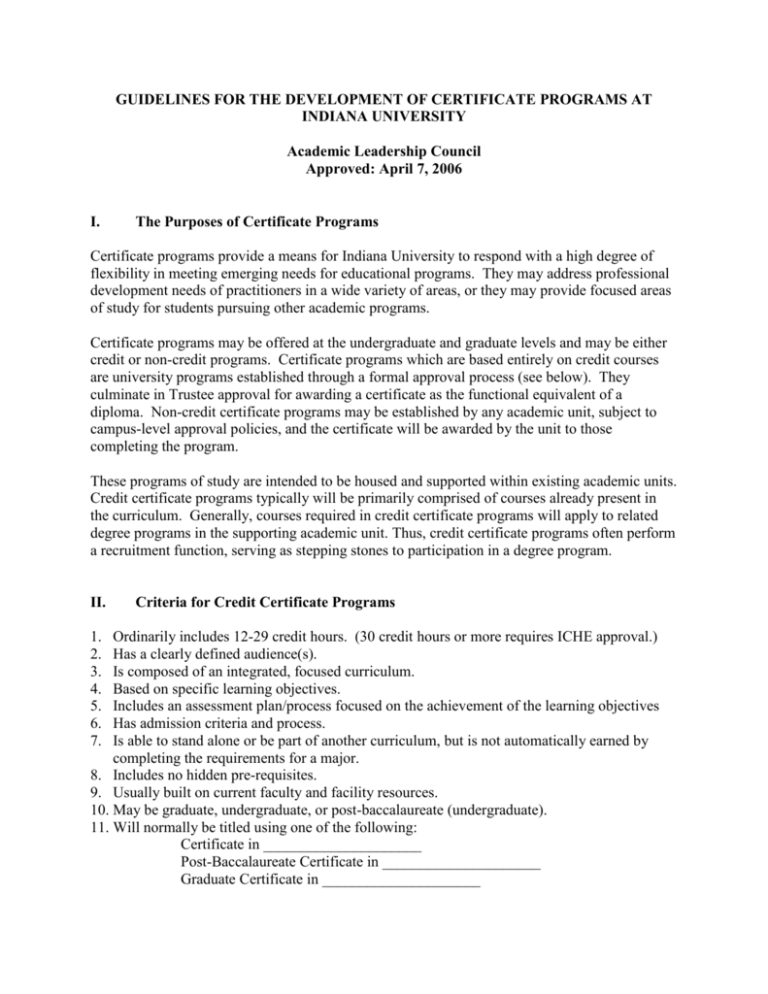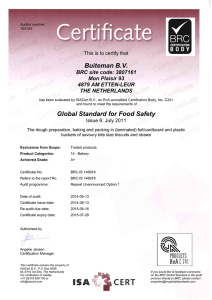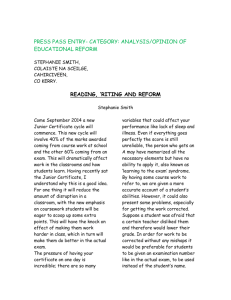Propose a New Certificate Program
advertisement

GUIDELINES FOR THE DEVELOPMENT OF CERTIFICATE PROGRAMS AT INDIANA UNIVERSITY Academic Leadership Council Approved: April 7, 2006 I. The Purposes of Certificate Programs Certificate programs provide a means for Indiana University to respond with a high degree of flexibility in meeting emerging needs for educational programs. They may address professional development needs of practitioners in a wide variety of areas, or they may provide focused areas of study for students pursuing other academic programs. Certificate programs may be offered at the undergraduate and graduate levels and may be either credit or non-credit programs. Certificate programs which are based entirely on credit courses are university programs established through a formal approval process (see below). They culminate in Trustee approval for awarding a certificate as the functional equivalent of a diploma. Non-credit certificate programs may be established by any academic unit, subject to campus-level approval policies, and the certificate will be awarded by the unit to those completing the program. These programs of study are intended to be housed and supported within existing academic units. Credit certificate programs typically will be primarily comprised of courses already present in the curriculum. Generally, courses required in credit certificate programs will apply to related degree programs in the supporting academic unit. Thus, credit certificate programs often perform a recruitment function, serving as stepping stones to participation in a degree program. II. 1. 2. 3. 4. 5. 6. 7. Criteria for Credit Certificate Programs Ordinarily includes 12-29 credit hours. (30 credit hours or more requires ICHE approval.) Has a clearly defined audience(s). Is composed of an integrated, focused curriculum. Based on specific learning objectives. Includes an assessment plan/process focused on the achievement of the learning objectives Has admission criteria and process. Is able to stand alone or be part of another curriculum, but is not automatically earned by completing the requirements for a major. 8. Includes no hidden pre-requisites. 9. Usually built on current faculty and facility resources. 10. May be graduate, undergraduate, or post-baccalaureate (undergraduate). 11. Will normally be titled using one of the following: Certificate in _____________________ Post-Baccalaureate Certificate in _____________________ Graduate Certificate in _____________________ III. Process for Development of Credit Certificate Programs 1. The first step in the process is for the head of the academic unit to notify the campus vice chancellor for academic affairs of the intention to proceed with the development of a certificate proposal. 2. Proposals must be prepared in the format available from the campus Vice Chancellor for Academic Affairs. 3. Proposals must be approved through the appropriate campus curriculum approval processes. 4. When appropriate, the certificate program proposal must be approved by the system-wide or core school. Graduate certificates must be approved by the appropriate graduate unit. System-wide or core school certificate program proposals must be approved by all affected campuses. 5. If additional state funding is required to offer the certificate, the chancellor or designated academic officer of the campus where the program is to be offered must submit one (1) copy of the program proposal to the University Budget Office, which will work with the academic unit in developing consistent approaches to estimating cost and identifying income sources for the program budget. 6. Following University Budget Office approval of the budget (if relevant) and completion of campus reviews, an electronic copy of the certificate program proposal is submitted to the chair of the Academic Leadership Council (ALC) by the campus vice chancellor for academic affairs/dean of faculties or by the dean of a system-wide school. 7. The chair of ALC will provide copies to members of the council approximately ten (10) days prior to its next scheduled meeting. ALC may approve with or without suggesting alterations, return to the initiating campus, table or defer, or disapprove. If approved, the proposal is forwarded to the Office of the Executive Vice President. 8. The Office of the Executive Vice President places the certificate program on the Trustee administrative action report. 9. If the certificate program requires thirty (30) or more credit hours, the Office of the Executive Vice President sends two (2) copies of the proposal to the ICHE for approval. The ICHE notifies the chief academic officers of the other six (6) state institutions of higher education and offers to send a copy of the proposal to parties that request them. Indiana University Request for a New Credit Certificate Program Campus: Proposed Title of Certificate Program: Projected Date of Implementation: TYPE OF CERTIFICATE: (check one) UNDERGRADUATE CERTIFICATES – These programs generally require 12-29 credits of undergraduate-level academic work. GRADUATE CERTIFICATES – These programs generally require 12-29 credits of graduate-level academic work or undergraduate academic work carrying graduate credit. POST-BACCALAUREATE CERTIFICATES –These programs generally require 1229 credits of undergraduate-level academic work, although students enrolling in these programs must have completed their baccalaureate degrees. I. Why is this certificate needed? (Rationale) II. List the major topics and curriculum of the certificate. III. What are the admission requirements? IV. List the major student outcomes (or set of performance based standards) for the proposed certificate. V. Explain how student learning outcomes will be assessed (student portfolios, graduate follow up, employer survey, standardized test, etc.) and describe the structure/process for reviewing assessment findings for the purpose of ensuring continuous improvement of the certificate. VI. Describe student population to be served. VII. How does this certificate complement the campus or departmental mission? VIII. Describe any relationship to existing programs on the campus or within the university. IX. List and indicate the resources required to implement the proposed program. Indicate sources (e.g., reallocations or any new resources such as personnel, library holdings, equipment, etc.). X. Describe any innovative features of the program (e.g., involvement with local or regional agencies, or offices, cooperative efforts with other institutions, etc.).





